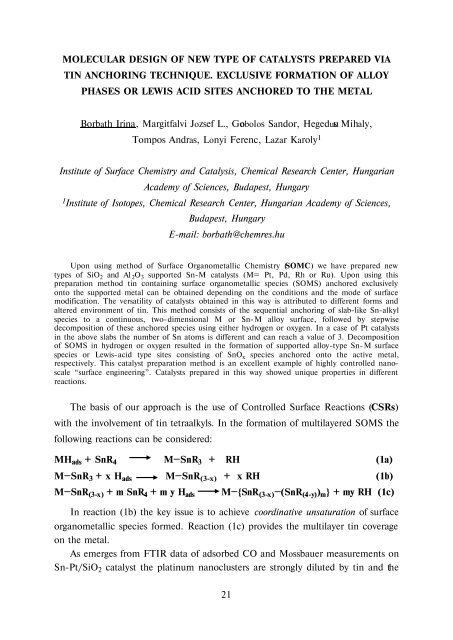ÐолекÑлÑÑнÑй дизайн каÑализаÑоÑов и каÑализ в пÑоÑеÑÑÐ°Ñ ...
ÐолекÑлÑÑнÑй дизайн каÑализаÑоÑов и каÑализ в пÑоÑеÑÑÐ°Ñ ...
ÐолекÑлÑÑнÑй дизайн каÑализаÑоÑов и каÑализ в пÑоÑеÑÑÐ°Ñ ...
You also want an ePaper? Increase the reach of your titles
YUMPU automatically turns print PDFs into web optimized ePapers that Google loves.
MOLECULAR DESIGN OF NEW TYPE OF CATALYSTS PREPARED VIA<br />
TIN ANCHORING TECHNIQUE. EXCLUSIVE FORMATION OF ALLOY<br />
PHASES OR LEWIS ACID SITES ANCHORED TO THE METAL<br />
Borbath Irina, Margitfalvi Jozsef L., Gobolos Sandor, Hegeduus Mihaly,<br />
Tompos Andras, Lonyi Ferenc, Lazar Karoly 1<br />
Institute of Surface Chemistry and Catalysis, Chemical Research Center, Hungarian<br />
Academy of Sciences, Budapest, Hungary<br />
1 Institute of Isotopes, Chemical Research Center, Hungarian Academy of Sciences,<br />
Budapest, Hungary<br />
E-mail: borbath@chemres.hu<br />
Upon using method of Surface Organometallic Chemistry (SOMC) we have prepared new<br />
types of SiO 2 and Al 2 O 3 supported Sn-M catalysts (M= Pt, Pd, Rh or Ru). Upon using this<br />
preparation method tin containing surface organometallic species (SOMS) anchored exclusively<br />
onto the supported metal can be obtained depending on the conditions and the mode of surface<br />
modification. The versatility of catalysts obtained in this way is attributed to different forms and<br />
altered environment of tin. This method consists of the sequential anchoring of slab-like Sn-alkyl<br />
species to a continuous, two-dimensional M or Sn-M alloy surface, followed by stepwise<br />
decomposition of these anchored species using either hydrogen or oxygen. In a case of Pt catalysts<br />
in the above slabs the number of Sn atoms is different and can reach a value of 3. Decomposition<br />
of SOMS in hydrogen or oxygen resulted in the formation of supported alloy-type Sn-M surface<br />
species or Lewis-acid type sites consisting of SnO x species anchored onto the active metal,<br />
respectively. This catalyst preparation method is an excellent example of highly controlled nanoscale<br />
“surface engineering”. Catalysts prepared in this way showed unique properties in different<br />
reactions.<br />
The basis of our approach is the use of Controlled Surface Reactions (CSRs)<br />
with the involvement of tin tetraalkyls. In the formation of multilayered SOMS the<br />
following reactions can be considered:<br />
MH ads + SnR 4 M–SnR 3 + RH (1a)<br />
M–SnR 3 + x H ads M–SnR (3-x) + x RH (1b)<br />
M–SnR (3-x) + m SnR 4 + m y H ads<br />
M–{SnR (3-x) –(SnR (4-y) ) m } + my RH (1c)<br />
In reaction (1b) the key issue is to achieve coordinative unsaturation of surface<br />
organometallic species formed. Reaction (1c) provides the multilayer tin coverage<br />
on the metal.<br />
As emerges from FTIR data of adsorbed CO and Mossbauer measurements on<br />
Sn-Pt/SiO 2 catalyst the platinum nanoclusters are strongly diluted by tin and the<br />
21
















